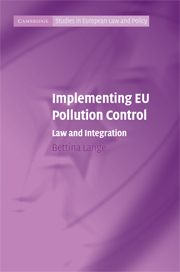24 results
Prevalence of Multidrug-Resistant Organisms in Hospitalized Pediatric Refugees in an University Children’s Hospital in Germany 2015–2016
-
- Journal:
- Infection Control & Hospital Epidemiology / Volume 37 / Issue 11 / November 2016
- Published online by Cambridge University Press:
- 15 August 2016, pp. 1310-1314
- Print publication:
- November 2016
-
- Article
-
- You have access
- HTML
- Export citation
6 - Getting to yes:1
-
-
- Book:
- Environmental Discourses in Public and International Law
- Published online:
- 05 March 2012
- Print publication:
- 02 February 2012, pp 143-169
-
- Chapter
- Export citation
Contributors
-
-
- Book:
- Environmental Discourses in Public and International Law
- Published online:
- 05 March 2012
- Print publication:
- 02 February 2012, pp x-xviii
-
- Chapter
- Export citation
8 - Does ‘law’ integrate? Licensing German and English coke ovens under the IPPC Directive
-
- Book:
- Implementing EU Pollution Control
- Published online:
- 07 August 2009
- Print publication:
- 17 April 2008, pp 227-263
-
- Chapter
- Export citation
2 - Traditional perspectives on the role of law in EU integration
-
- Book:
- Implementing EU Pollution Control
- Published online:
- 07 August 2009
- Print publication:
- 17 April 2008, pp 28-54
-
- Chapter
- Export citation

Implementing EU Pollution Control
- Law and Integration
-
- Published online:
- 07 August 2009
- Print publication:
- 17 April 2008
5 - Talking interests – generating procedure: How political discourse constructs key aspects of BAT determinations in BREFs
-
- Book:
- Implementing EU Pollution Control
- Published online:
- 07 August 2009
- Print publication:
- 17 April 2008, pp 104-141
-
- Chapter
- Export citation
4 - What is EU ‘law in action’?
-
- Book:
- Implementing EU Pollution Control
- Published online:
- 07 August 2009
- Print publication:
- 17 April 2008, pp 86-103
-
- Chapter
- Export citation
Abbreviations
-
- Book:
- Implementing EU Pollution Control
- Published online:
- 07 August 2009
- Print publication:
- 17 April 2008, pp xvii-xx
-
- Chapter
- Export citation
Frontmatter
-
- Book:
- Implementing EU Pollution Control
- Published online:
- 07 August 2009
- Print publication:
- 17 April 2008, pp i-viii
-
- Chapter
- Export citation
Index
-
- Book:
- Implementing EU Pollution Control
- Published online:
- 07 August 2009
- Print publication:
- 17 April 2008, pp 316-324
-
- Chapter
- Export citation
9 - Conclusion
-
- Book:
- Implementing EU Pollution Control
- Published online:
- 07 August 2009
- Print publication:
- 17 April 2008, pp 264-291
-
- Chapter
- Export citation
Update on the IPPC Directive
-
- Book:
- Implementing EU Pollution Control
- Published online:
- 07 August 2009
- Print publication:
- 17 April 2008, pp xiv-xvi
-
- Chapter
- Export citation
Bibliography
-
- Book:
- Implementing EU Pollution Control
- Published online:
- 07 August 2009
- Print publication:
- 17 April 2008, pp 304-315
-
- Chapter
- Export citation
Contents
-
- Book:
- Implementing EU Pollution Control
- Published online:
- 07 August 2009
- Print publication:
- 17 April 2008, pp ix-x
-
- Chapter
- Export citation
Series editors’ preface
-
- Book:
- Implementing EU Pollution Control
- Published online:
- 07 August 2009
- Print publication:
- 17 April 2008, pp xi-xii
-
- Chapter
- Export citation
Appendix: Methodology
-
- Book:
- Implementing EU Pollution Control
- Published online:
- 07 August 2009
- Print publication:
- 17 April 2008, pp 292-303
-
- Chapter
- Export citation
1 - Introduction
-
- Book:
- Implementing EU Pollution Control
- Published online:
- 07 August 2009
- Print publication:
- 17 April 2008, pp 1-27
-
- Chapter
- Export citation
3 - Critical perspectives on the role of law in EU integration
-
- Book:
- Implementing EU Pollution Control
- Published online:
- 07 August 2009
- Print publication:
- 17 April 2008, pp 55-85
-
- Chapter
- Export citation
6 - Variation in open and closed BAT norms
-
- Book:
- Implementing EU Pollution Control
- Published online:
- 07 August 2009
- Print publication:
- 17 April 2008, pp 142-190
-
- Chapter
- Export citation



